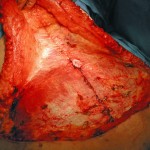
Frequent questions about the internal tightening of a tummy tuck include whether the muscles are cut, how tight they are made and what the recovery will be like. (e.g., how long will it be before I can stand up straight?) Such questions, while understandable, reflect a basic misconception of how this part of the operation is really done.
While there are numerous abdominal muscles, the only ones that are manipulated in a tummy tuck as the central ones known as the rectus muscles. These are very big, wide and long muscles that run vertically from the lower edge of the rib cage all the way down to the pubic region. They are the largest of the abdominal muscles and make up the entire central part of the abdominal musculature. Like all muscle, they are encased ion fascia very much like a casing around sausage. This covering or fascia is very thick and stout in comparison to the muscle which is very soft and jelly-like.
While the paired rectus muscles normally meet in the midline, pregnancy can cause these vertically-oriented muscles to separate and a gap develop between them. This is most evident below the belly button but can also extend above the belly button as well. This gap does not mean that the abdominal contents are exposed as the overlying fascia remains attached but stretched. There is a resultant midline muscle deficiency but not a fascial separation. Occasionally a hernia may be present because of this separation around the bellybutton, which is a natural weak point of the fascia.
When these muscles are tightened during a tummy tuck, no muscle is ever cut. Rather, the rectus muscles are brought back together in the midline by sutures which sew the fascia, not the muscle together. Technically, this maneuver is a fascial tightening, not a true muscle tightening. When done properly and with care, there is minimal trauma or injury to the muscle tissue which lies immediately underneath these fascial sutures. What type and size of sutures used to do this midline rectus fascial tightening is a matter of a plastic surgeon’s preference.

It is this fascial tightening that induces much of the discomfort after tummy tuck surgery. It is also that which make can make it difficult to stand erect in the first few days after surgery. However if the fascial tightening is not overdone most patients can stand erect and their pain is not unduly severe.
Dr. Barry Eppley
Indianapolis, Indiana


